Originally from outside of Philadelphia, USA, photographer Eric Seidner (Instagram @eseidner) has been in China since 2004, and came to Shanghai in 2010. Before that he lived in Nepal, where his passion for photography was ignited.
Today sees the opening of his debut Shanghai exhibition at La Cava de Laoma, with an opening party taking place on Saturday. We sat down with Seidner to talk inspiration, Instagram and how he went about finally getting his work hanging on a wall.

How did you get into photography?
My interest in photography coincided with my first travels outside of the United States during my early twenties.
I lived in Nepal for a period of time, and there the culture was so rich and pronounced – so different – that I wanted to somehow capture what I was seeing to share with friends and family back home.
All I had was a very basic point and shoot camera – no bells and whistles. Point, click, that’s it. But it started me asking questions.
See, I remember being a child and having had to endure the endless slideshows my uncle forced the family to sit through after he’d return from an exotic adventure.
The stories he told were good, but the images he showed were not – real thumb-in-the-frame type of shots. They were enough to tarnish the glow of the adventure.
So, I began asking myself – what makes a good shot. Or at least – what will make for a non-boring slideshow?
But I was a real crap photographer for ages. My first evolution was when a friend of mine, a photographer at a Philadelphia newspaper and magazine, sold me his used DSLR (Nikon D70).
That camera was totally out of my league at the time! So many buttons and controls – not to mention the weight and size. Yet, it forced me to learn about focal length, shutter speed, aperture, etc.
Over time, practice practice practice led to better outcomes. But it wasn’t until years later when I joined Instagram that I made another serious evolution in skill level.
Suddenly, I was putting photos out in public and getting real feedback, making experienced connections, and observing thousands and thousands of images. I invested in Lightroom and, just as learning to edit makes a better writer, so does it make a better photographer.
Sometime around 2017, passion and learning really kicked in and I felt myself improving rapidly after years of relative stagnation.
More recently, I switched to a mirrorless (Nikon Z7 ii) and picked up droning (Mavic Air 2), which has been an entirely new set of skills to learn, like moving from snorkeling across the surface to scuba diving – whole new dimensions of movement become available.
I’m still a ridiculously nervous flyer – I once crashed into a waterfall outside of a hanging temple and relied on monks to fish out my drowned drone from the bottom of a carp pond, but I do love the extra perspectives I now have access to from above.
How do you choose where to shoot?
I usually choose where I want to travel first, then the photography mostly happens along the way. I believe a travel photographer should have “an eye” and be able to pick moments along a journey as they encounter them.
This is why I tend to avoid 网红 locations, as they have been done to death – I think they can be helpful spots for those just learning to shoot as the scene is already set up, but I really enjoy the process of discovering my own take on a location or in finding a scene that just exists for that moment and is gone the next.
Through countless travels, I’ve developed a pretty decent hunch on where to truffle-hunt a good photo. Plus, I love to stumble about and am deeply curious – so I follow my instincts and have often been rewarded with unexpected photographic finds.
Occasionally, I have researched locations in advance or asked my Instagram connections for recommendations. But it is hard to distinguish this as photographic research rather than overall trip planning. Only a few times have I traveled somewhere just to obtain a specific photo.
What do you look for in a photograph?
For me, the highest ideal for a photograph is to tell a story. I have a literary background and am a hobbyist writer, so I have a natural affinity for photographs that reveal a sense of place and sense of character, and then demonstrate a relationship between them.
I have great admiration for photographers who can constantly achieve this. In my personal work, this is a goal I aspire towards, but often struggle to achieve.
I think the very best of my work features story-telling qualities, but when I can’t achieve that I hope to at least convey a sense of place or person. In the very least, I’ll aim for composition or aesthetics.
I don’t have a particular niche and am comfortable attempting a wide variety of subject-matter and styles, although “travel” is the common thread running through most of my work.
Experiencing unfamiliar places and cultures lends itself to a story-telling approach as it will spark my curiosity and encourage me to ask narrative-building questions through my lens – who is this person? Why do they follow this custom? What is special about this environment?
Slowly, I will try to piece it all together. Once I’m engaged, I can sit with a scene for a very, very long time. It is both parts adult-play and mystery-solving. I have to decide what is in and out of frame. Find the right angle. Anchor to a subject. Choose a decisive moment.
Favorite place to shoot in Shanghai?
Actually, it wasn’t until recently that I started photographing places in Shanghai. I guess it has always been a bit like the old joke of the Parisian who had never once visited the Eiffel Tower – despite having the most famous spot in one’s own backyard, there just isn’t an urgency to go visit it.
Besides, I had always associated my photography with travel and Shanghai was simply my home.
That began to change with the pandemic. First, international travel was no longer an option, and then domestic travel became increasingly difficult.
Finally, with so many friends beginning to leave Shanghai, I felt a dawning sense of impermanence and that I’d hate for my time in Shanghai to conclude without me having ever documented this great city.
I began thinking of some of the more iconic areas around the city and decided to (slowly) visit these in turn and capture them in my own way. As I began to do that, I started to become accustomed to taking my camera around the city and began shooting whenever I caught an interesting moment – some of my favorite “Shanghai” shots have happened in random locations.
Finally, there was the lockdown. I was fortunate enough to live in a building that lifted restrictions earlier than many others, so I tried to document scenes around the city when so many other photographers were unfortunately limited to the view from a window or balcony.
That time was a tie that binds – a shared link that connected everyone throughout the city. For myself, I felt it was important to document and personally I found it therapeutic to process the experience through imagery.
And outside of Shanghai?
Anywhere far away from the tourists!
I like to explore at my own pace, so jostling for position or trying to click-and-go at a scene is not my thing. I’d much rather walk around a single village for hours than hop from location to location.
I often enjoy basing in a location for a few days and just heading out in a different direction each morning to see what there is to see.
How is the Instagram community in Shanghai and China?
Generally speaking, I have found a good level of openness and friendliness among the travel photography community in Shanghai and China.
At one point, I even belonged to a small private “Asia Crew” group of Instagram photographers whose members were based across China – and, over the years, we even managed to turn online relationships into offline friendships. I still meet with several of them to this day.
To plug into the community, I think honest engagement is key: follow an account you like, meaningfully comment on their photos and start asking them thoughtful questions about their work and experiences. You’d be surprised how people respond when they sense genuine interest in their account.
People often like to talk about themselves and their work or like to be viewed as a source of expertise from which to offer advice. So ask a good question and be a great listener – start a conversation.
Yet it can take time to build credibility and an online relationship. Some Instagram users are hesitant to reveal the locations in their photos or partner with other users until they can get a sense of “like mindedness” or trust. Therefore, it might take some giving and generous sharing from one’s own end to get the connection going.
But several of my photography trips have benefitted from recommendations from those in the Insta community, and overall I truly think I have improved as a photographer from having exposure to so many great Instagram connections.
What advice would you give someone trying to build up an Instagram account?
I think Instagram is best approached with a clear expectation as to how you want to use it as a tool.
For me, I primarily use Instagram to seek community rather than to chase growth; volume of numbers means much less to me than quality of interactions.
As a result, I break many of the platform’s cardinal rules with my photos: I don’t post regularly, take selfies, feature trendy sites, use Reels or vertical orientation and I don’t write catchy little captions – in fact, I write long and often personal stories.
This leaves me with a curated gallery of photos and a sort of ongoing diary, through which I have made many strong connections and friendships that have lasted years.
For other users, they may have a business to promote or a personal brand and may therefore approach the platform very differently – which is fine, just not for me.
However, if I had two bits of advice for someone who is a travel photographer just starting out on the platform, I’d say “quality” and “community.”
First, post only your best material – only post bangers.
Second, don’t chase followers for follower’s sake. Instead, find a good community of like-minded individuals.
There are plenty of China or Shanghai-related Instagram accounts (as well as general photography ones) where you can meet individuals who share the same passion or tastes in photography.
You can receive helpful feedback and advice that bring you deeper into your craft, find great recommendations on travel, and make some good friends.
If you could shoot a place you have not yet, where would it be?
For China, I’ve always wanted to visit Xinjiang. In terms of culture and landscape, I think it is right up my alley. But I have a feeling that I’d need a large swath of time to travel there in any meaningful way, and the pandemic has meant I’ve needed to postpone these plans.
Outside of China, I’d love to visit Iceland! I am a sucker for a good ol’ road trip and would love to rent a vehicle and drive across that fantastically surreal landscape with my drone in tow.
How did the debut exhibition come about?
Hanging my photographs on a wall has always been a goal of mine.
While the initial stages of photography – from capturing the shot to post-production editing – are personal and private, creating a print is about sharing it with others for appreciation and interpretation; when someone takes home a print, the artwork takes on a life of its own, separate from the artist.
I've had this intention for a while, but wasn't sure how to make it happen. It's not like you can just randomly approach galleries.
Luckily, a friend, Fabiola Liacy De Felip (brand “ByFab”), who is an accomplished travel photographer with many exhibitions under her belt, helped me bring this goal to fruition.
READ MORE: ByFab Photography on The Art of Capturing Human Emotion
She introduced me to Mariano, the owner of La Cava de Laoma, a wine bar and gallery. After reviewing my portfolio, we agreed on a month-long exhibition.
La Cava provides an ideal space with its ample, well-lit walls, and wine being within arm’s reach is an added bonus.
What can people expect from the exhibition?
Big Picture: Gestalt Patterns In Photography brings together a unique theme and immersive experience for a distinctive viewing encounter.
My hope is that guests not only discover visually impactful travel photography, but also gain insights into how their own mind naturally recognizes and processes visual complexity.
Gestalt, a psychological school from the early 20th century, has outlined specific principles explaining how our minds organize complex visuals into patterns.
Artists and graphic designers have employed these principles for decades to create art that aligns with our mind's interpretation of visual stimuli.
Each exhibited photograph will include a caption explaining the demonstrated Gestalt design principle, and will also serve as an example of how incorporating a specific principle enhances photographic composition.
Big Picture: Gestalt Patterns In Photography
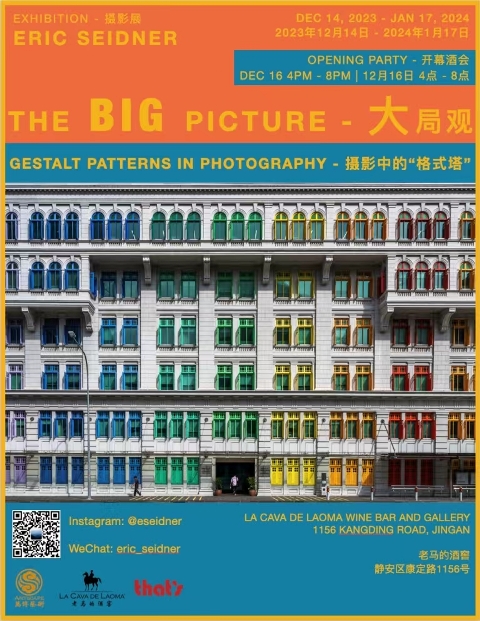
Exhibition: Thu Dec 14, 2023 to Wed Jan 17, 2024; Free.
Opening Party: Sat Dec 16, 4-8pm; Free.
La Cava de Laoma, 1156 Kangding Lu, by Wuning Nan Lu 康定路1156号, 近武宁南路.
Here, Seidner introduces six of the photographs that will be in the exhibition...
Labyrinth
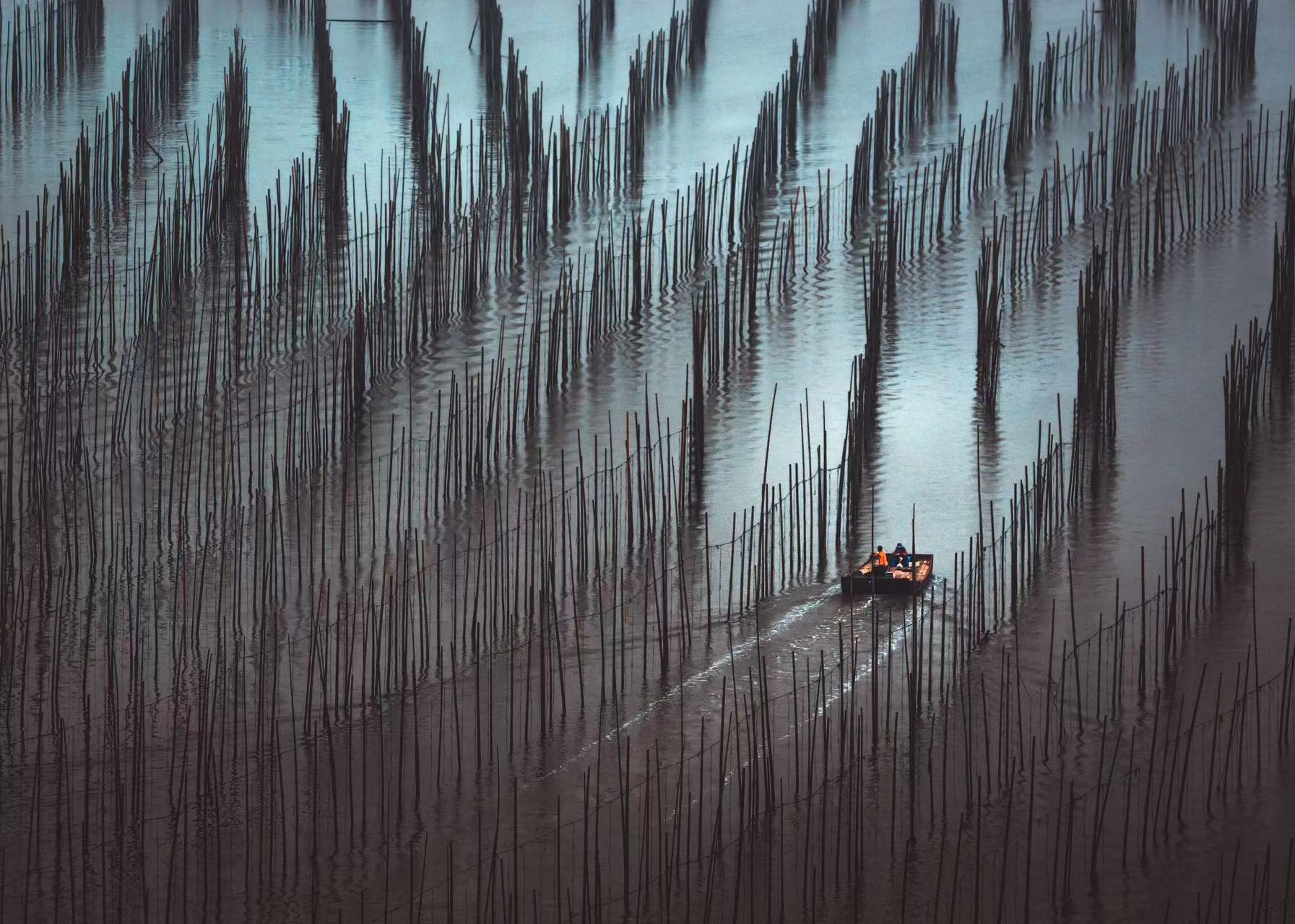
“This photo represents my enjoyment of getting a bit off the beaten path, even though the area of Xiapu is becoming more well-known amongst professional photographers.
“To get this view I had to climb to the roof of an abandoned building in a fishing village. In frame, a boat maneuvers towards an exit from within a maze of bamboo poles as an approaching storm darkens the sky.
“These poles – tens of thousands of them speared into the sea and stretching towards the horizon – are a characteristic of China’s largest mudflat, Xiapu, and are used by fishermen to festoon seaweed for drying.”
Golden Prosperity Building

“This is not only one of my first Shanghai shots after having lived in the city for years, but it also represents the silly amount of patience I will employ to get the photo I want.
“The beautiful golden ringed pattern on the interior of Jin Mao Tower makes for a great shot all on their own, but I wanted a human subject and envisioned including a spectator on the balcony.
“I had to wait nearly an eternity with my camera held in position for that man in the lower right to pop out on the balcony with his phone to complete my composition.”
Leviathan
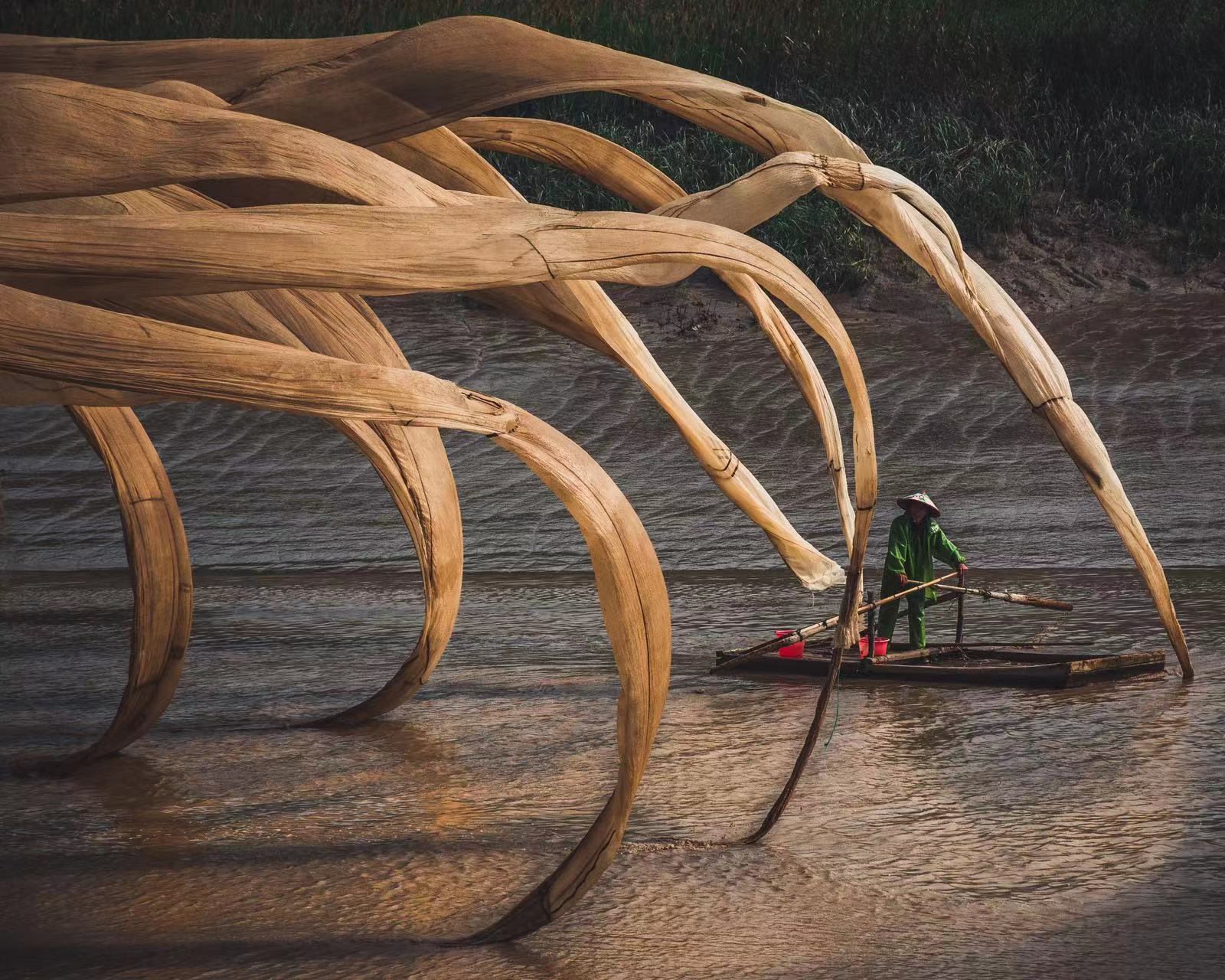
“This is another of my all-time favorites and shows the power of choice a photographer has in framing a shot.
“In reality, it is a fisherman checking fishing nets blowing in the wind. But with a simple choice of crop it becomes something much more menacing – a tentacled leviathan closing in on a victim.”
Dragon Catches The Pearl

“Mythical Chinese dragons are often portrayed chasing a flaming pearl, symbolizing spiritual prosperity, power, or wisdom.
“In this candid morning shot of the Bund, dragon dancers toss their dragons high into the air, creating the illusion of these creatures hovering over and about to catch the 'Pearl' Tower.
“The resulting photo made the early rise well worth it.”
Writ In Water
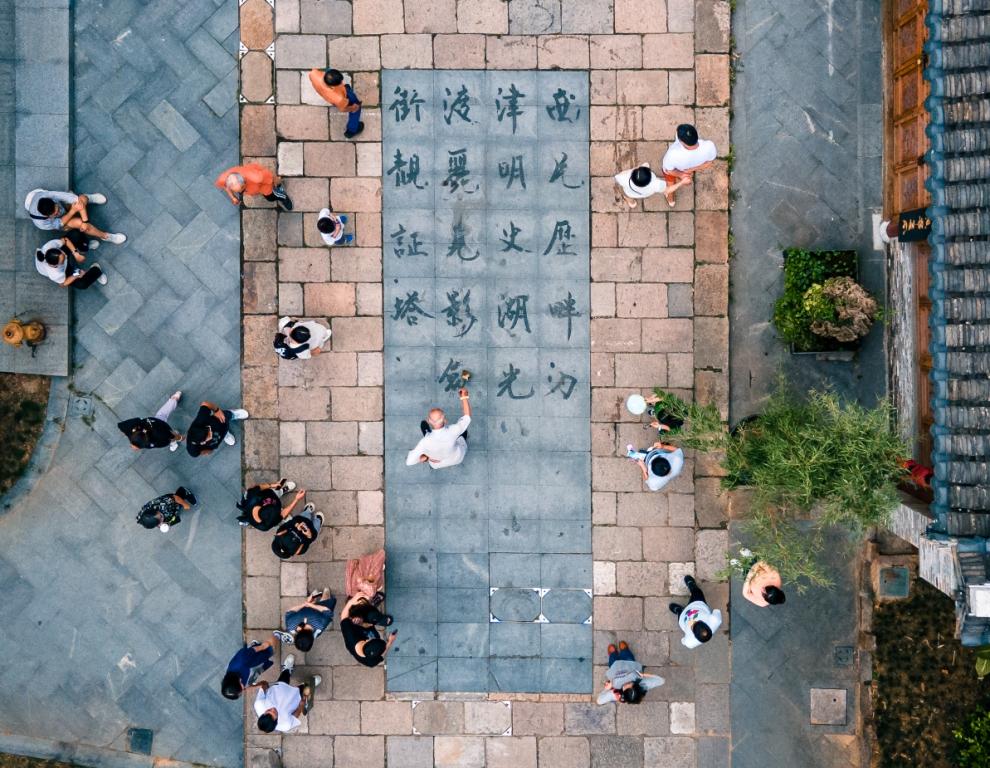
“I love capturing unplanned moments during my explorations.
“For example, during my visit to Zhenjiang, renowned as the home of vinegar, I stumbled upon an elderly man crafting sidewalk poems with a large calligraphy brush dipped in water.
“His verses described and praised the location.”
The Rainbow Headquarters
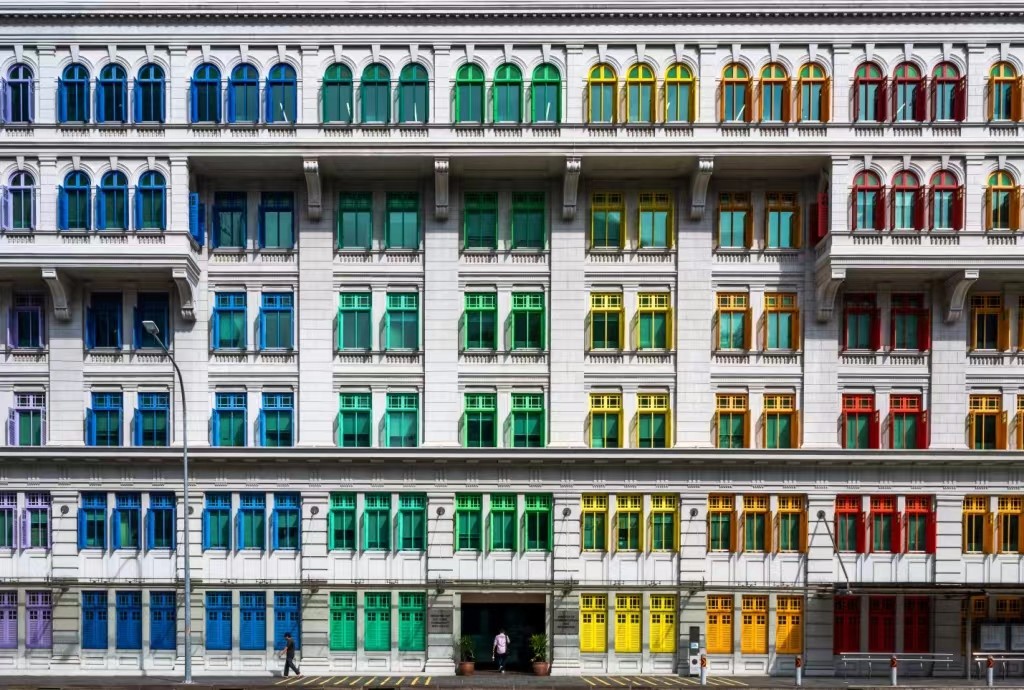
“The Old Hill Street Police Station in Singapore is striking on its own, showcasing a vibrant pattern of ROYGBIV window shutters.
“Yet, to align with my aesthetic, I prefer to include an individual in the frame to offer both a sense of scale and a narrative focus.
“Achieving this involves a bit of a challenge, as it relies on the participation of strangers.
“Without the ability to direct them, I patiently wait for the right person to naturally come along and contribute an action that enhances the overall composition.”
Follow Eric Seidner on Instagram @eseidner
[All images courtesy of Eric Seidner/@eseidner]





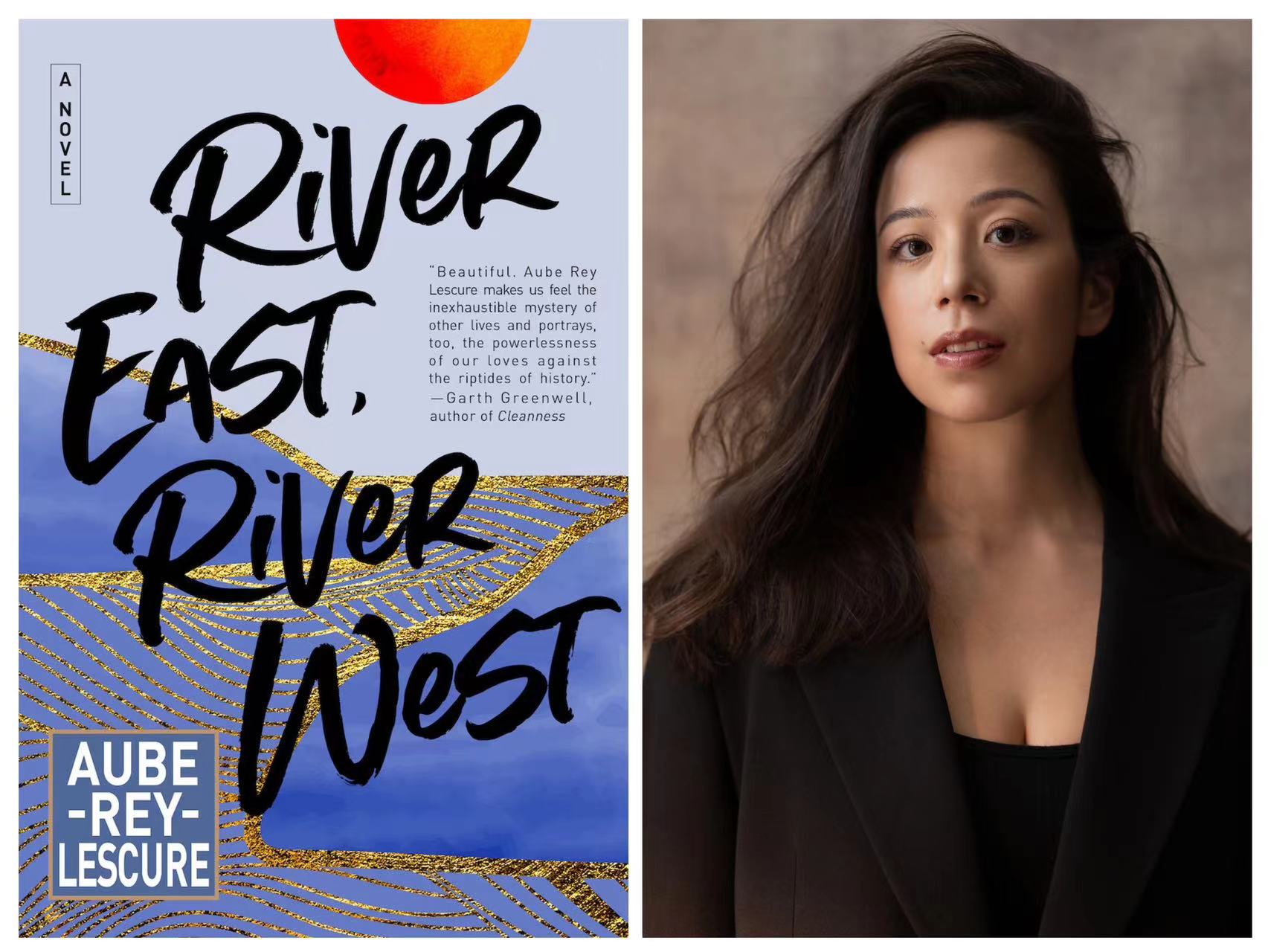















0 User Comments